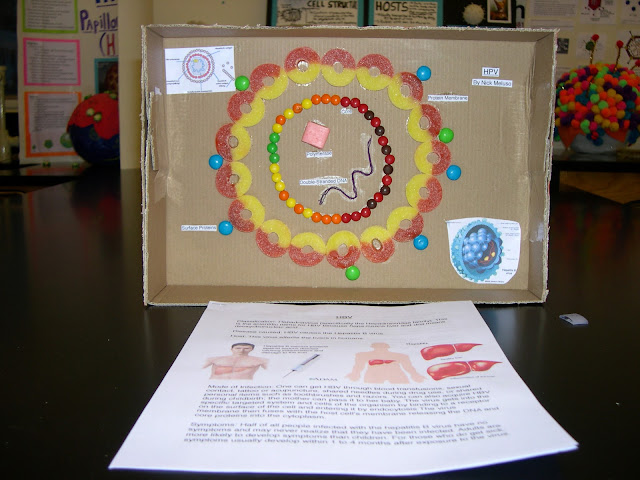Each student completed a poster/paper that described the cause and effect of a viral disease. They also examined the structure and life cycle of each virus, as one of the major tenets of biology is the interconnectedness of structure and function.
In all sciences, the building of models is often used to clarify the ways in which natural systems work. In some cases the models can be mathematical, such as the Hardy Weinberg population genetics equation, in other cases the model might be computer generated, like those used to predict the weather. Mrs. Bastone's students produced 3D physical representations of the different viruses to better understand the relationship between structure and function.
Dengue Fever Virus
 |
| M. Campbell's work on the dengue fever virus |
 |
| C. Cory's presentation on the dengue fever virus |
Rabies Virus
 |
| M. Lewis' representation of the rabies virus |
 |
| N. McManus' work on the rabies virus |
Adenovirus
 |
| N. Kister focused on the adenovirus which causes the upper respiratory infections better known as the common cold |
 |
| G. Neff looked at the adenovirus which causes "pink eye" or conjunctivitis an inflammation of the protective mucous membrane of the human eye. |
Chicken Pox Virus
 |
| J. Flangos prepared his poster on the chicken pox virus, which in older people, who have had the infection can in later life cause the disease of nerve endings, known as shingles |
 |
| Emma H's representation of the chicken pox virus |
West Nile Virus
 |
| M. Donovan prepared her poster on the West Nile Virus |
 |
| J. Carroll's paper and model of the West Nile Virus |
Hepatitis B Virus
 |
| F. Gallo's Hepatitis B poster and model |
 |
| N. Meluso chose to represent his model of the hepatitis B virus in cross section |
Herpes Virus
 |
| E. Hanrahan's poster and model of the herpes simplex virus |
 |
| M. Kapsis' poster and model for the herpes virus |
Human Papilloma Virus
 |
| Human Papilloma Virus (HPV) was researched by G. Vetromile |
Small Pox Virus
 |
| T. Pennoyer studied the small pox virus |
Enterobacteria Phage T4 Virus
 |
| The model to the left is O. Estes' HIV virus and the model to the right is C. Kantzoglou's model of the "classic" example of a bacteriophage, the enterobacteria phage T4 |
Hendra Virus
 |
| O. Jones's model represented the hendra virus |
Rotavirus
 |
| The rotavirus was represented in this model by J. Dutton |







